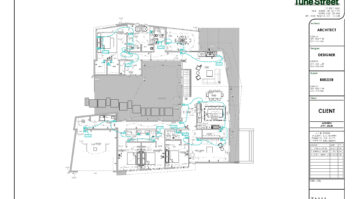A year after I purchased my father’s installation company, my husband and I bought the property on which the store is located. Fast forward to 2017, and the façade was in desperate need of repair. Instead of band-aiding the issue, we secured an architect to come up with a design to give the buildings a cohesive appearance. There are three buildings on the property—two we work out of, and one rental property.
Construction has begun. There’s concrete work to be done. Creating new sidewalks revealed the need to install new sewer lines, which uncovered a collapsed drainage tile. It has been 30 days, and I cannot help but feel we have only been making a mess so far.

At the end of all of this, our store will have a fresh exterior look. Yet, I have begun to second-guess myself about whether or not investing in the retail portion of the business was actually a good idea.
Toys “R” Us filed for bankruptcy in early September. Payless, RadioShack, J. C. Penny, Macy’s, Sears, Kmart, and H.H. Gregg are all big brands that are gone or dying a slow painful death. With names like these on the chopping block, it is easy to believe that retail, as we know it is over.
And yet, according to the National Retail Federation (NRF), “Over the last decade, retail sales and jobs have continued to grow despite challenging economic conditions. And despite the press on store closings, data from IHL Group shows a net increase in store openings of over 4,000 in 2017.”
Crazy, right? When scouring the internet a bit more, I found an article from Forbes that “all but one of the top-10 U.S. retailers are physical chains.” That’s right, we all know our favorite beast Amazon, but the others are Wal-Mart, Kroger, Costco, The Home Depot, CVS, Walgreens, Target, Lowe’s, and Albertsons.
Another study from Alix Partners showed steady declines from online purchases even though the sales themselves increased 5 percent over five years. This fact reminds me of one of my favorite tips from a fellow AV friend, “Sometimes the most profitable job you take is the one you say no to.” The goal is not just to increase sales, but our bottom line. No one wants to work only to continue to work.
Add to these fun facts that Amazon recently purchased Whole Foods for 15 billion dollars, which is a significant investment into brick and mortar from the most prominent online retailer. Whole Foods was the 30th largest retailer before the purchase, according to NRF.
And to drive it all home, Millennials are about to become the generation with the most buying power, and they “are more inclined to shop in-store than online.” (CBRE Group Inc.)
From Millennials to Boomers, we are all craving the same thing: human contact and relationships. We all feel better when we have somewhere to call after we make a large purchase, no matter the age or generation. What we need to do to capitalize on this is answer your phone or call the client back when they leave a message. Be proactive.
Back to my conundrum of the future of my retail location: I have decided to stay the course, but with the caveat of not being open long hours each day. We will continue to be open during usual business hours, but also by appointment. We will close this Black Friday so my hardworking team can stay at home with their families, but offer Black Friday deals throughout the rest of the month. Because who needs the pressure of getting up at 4 a.m. to try to grab a deal on a TV that will probably be sold out by the time you get there?
Still need more convincing? Buxton, the industry leader in customer analytics, tells us that, “While digital has been one of the principal disrupters in retail, pure-play online retailers, such as Amazon, only account for 5 percent of total U.S. retail sales with an additional 5 percent of retail sales categorized as multi-channel.
That means that 90 percent of retail sales are still happening where sales have taken place for hundreds of years: in physical stores.
And that also means that 95 percent of all retail sales are captured by retailers that have a physical presence.
Retail is not dead. It is evolving.







